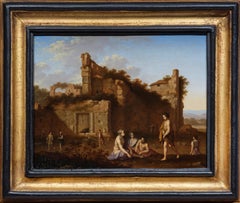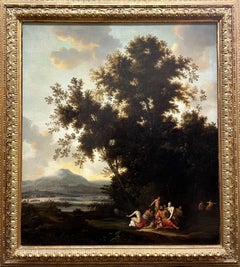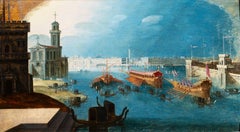17th Century Landscape Paintings
to
82
33
26
46
44
74
Overall Width
to
Overall Height
to
557
3,072
17,153
27,602
341
333
533
646
711
910
980
1,059
1,002
933
294
122
2
1
168
53
1
169
78
62
29
17
17
15
14
13
8
7
6
6
6
5
5
4
4
4
3
219
215
65
65
25
6
1
1
1
1
198
17
208
15
Period: 17th Century
View of an Antique City, a wash landscape by Jan de Bisschop (1628 - 1671)
Located in PARIS, FR
The attribution to Jan de Bisschop has been confirmed by the RKD with the following comment: "We base this attribution on the dark washes, the subject represented and the monogram".
...
Category
Old Masters 17th Century Landscape Paintings
Materials
Ink, Pen
A 17th c. Italian school, Capriccio with the Colosseum, circle of V. Codazzi
Located in PARIS, FR
A capriccio with the Colosseum in Roma
17th century Italian school
Circle of Viviano Codazzi (1604-1670)
Oil on canvas
Dimensions: h. 35.43 in, w. 51.18 in
Modern 17th century style ...
Category
Old Masters 17th Century Landscape Paintings
Materials
Canvas, Oil
Gathering in antique Ruins, a monogrammed painting by Jan van Haensbergen
By Jan Van Haensbergen
Located in PARIS, FR
Jan van Haensbergen was a painter of the Dutch Golden Age and a pupil of Cornelius van Poelenburgh (Utrecht 1594 - 1667). The painting we are presenting is inspired by Poelenburgh’s landscapes from his Italian sojourn. The dreamlike atmosphere of this Gathering in antique ruins appealed to us. Against a backdrop of antique ruins, three draped characters (perhaps bathers) are sitting in a circle, greeting a fourth character walking towards them.
Their tranquility contrasts with the bustle of the other characters in the background. They constitute a vivid illustration of otium, this leisure time that allows us to realize our full potential. With this Arcadian landscape, Jan van Haensbergen invites us in turn to leave the hustle and bustle of everyday life behind, to take a break, to enjoy the present moment chatting with close friends…
1. Jan van Haensbergen, a landscape and portrait painter of the Dutch Golden Age
Jan van Haensbergen was born in 1642 in Gorinchem, a town in southern Holland to the east of Rotterdam. He was a pupil of Cornelius van Poelenburgh, and began by painting landscapes inspired by those of his master, in an Italianate style. Between 1668 and 1669, he was registered at the Guild of Saint Luke in Utrecht.
In 1669, he moved to The Hague, where he joined the Confrérie Pictura, an artist society founded in 1656. His portraits, which became his main activity as a painter after settling in The Hague, were strongly influenced by Caspar Netscher (Prague or Heidelberg 1639 - The Hague 1684), whom he met in The Hague and whose son Constantijn became his son-in-law by marrying his daughter Magdalena.
In addition to his work as an artist, Van Haensbergen was also an art dealer, probably helped by his appointment as Dean of the Confrérie Pictura, where he also teached.
2. Description of the artwork and related paintings
This painting seems to us to be a kind of allegory of otium, that quiet bliss promised by Epicurus. It might even evoke an Epicurean proverb: "It is better to lie on the naked ground and be at ease, than to have a golden carriage and a rich table and be worried" .
Three draped young people - two men and a woman in the background - are seated in a circle, greeting a fourth figure walking towards them, hair disheveled and body draped in a towel as if drying off after a bath, indicating the need for prior purification to fully enjoy this rest. Their nonchalance contrasts with the bustle of the various characters in the background.
The composition is punctuated by successive diagonals, and opens onto a landscape on the right, with a succession of mountainous planes. This painting is typical of the Italianate works produced by Van Haensbergen in the 1660s under the influence of Cornelis van Poelenburgh...
Category
Old Masters 17th Century Landscape Paintings
Materials
Oak, Oil
Important 17' Century Mythological Painting Diana and Actaeon Oil on Canvas
Located in Rome, IT
Fascinating mythological story of Diana and Actaeon can be found in Ovid’s Metamorphoses.
Very important provenance from a royal collection. Fabulous finely carved gilt wood coeval frame .
Giovanni Battista Viola...
Category
Baroque 17th Century Landscape Paintings
Materials
Oil
"Satyrs and Nymphs in a Landscape"
By Daniel Vertangen
Located in Edinburgh, GB
Attributed to Daniel Vertangen (1601–1683) – "Satyrs and Nymphs in a Landscape"
Artist: Attributed to Daniel Vertangen (1601–1683)
Title: "Satyrs and Nymphs in a Landscape"
Medium:...
Category
Realist 17th Century Landscape Paintings
Materials
Canvas, Oil
Ascension day in Venice by Louis de Caullery (1582-1621) 17th c. Flemish school
Located in PARIS, FR
Ascension Day in Venice
17th century Antwerp School
Louis de Caullery (1582-1621)
Oil on oak panel
Dimensions: h. 12.8 in, w. 23.03 in (h. 32,5 cm, w. 58,5 c...
Category
Old Masters 17th Century Landscape Paintings
Materials
Oak, Oil
Port with Villa Medici
Located in Fort Washington, PA
Original painting of 1637 owned by the Uffizzi Museum in Florence, Italy. This is a fully restored copy.
Category
17th Century Landscape Paintings
Materials
Canvas, Oil
Circle Wouwerman, Horseman by a Tent, Riders Playing Cards, Dutch Old Master
By Philips Wouwerman
Located in Greven, DE
Circle Wouwerman, Horseman by a Tent, Riders Playing Cards (?), Old Master
Dutch Art, Travellers or Riders resting by a tent and gambling
Category
Baroque 17th Century Landscape Paintings
Materials
Canvas, Oil
$4,279 Sale Price
20% Off
17th Century by Giovan Battista Discepoli Coronation of Thorns Oil on Panel
Located in Milano, Lombardia
Giovan Battista Discepoli, also called the "Zoppo from Lugano" [Castagnola (Lugano), Switzerland, 1590 - Lugano, Switzerland, 1654]
Title: Coronation of Thorns
Medium: Oil on panel
D...
Category
Old Masters 17th Century Landscape Paintings
Materials
Panel, Oil
HUYSMANS Flemish Landscape Painting 17th 18th Baroque Monks Hermit Pilgrims
By Cornelis Huysmans
Located in PARIS, FR
Cornelis HUYSMANS (Attributed to)
Antwerp, 1648 – Mechelen, 1827
Landscape with pilgrims visiting hermits
Oil on canvas 49.2 x 58.5 cm (60 x 69.7 cm with frame)
Not signed
Old stamp ...
Category
Baroque 17th Century Landscape Paintings
Materials
Oil
The Flight of Sodom and Gomorrah - Entourage of Monsu-Desiderio
Located in Saint-Ouen, FR
Italian School 17th Century
Close to Monsu Desiderio
The Flight of Sodom and Gomorrah
Oil on canvas
Framed with Black wood and golden ornementation
Di...
Category
Academic 17th Century Landscape Paintings
Materials
Oil
Two Scenes of Diana and Actaeon (a pair)
Located in New York, NY
Provenance:
Robert L. and Bertina Suida Manning, New York, until 1996
Private Collection, USA
Giovanni Battista Viola was born in Bologna a...
Category
Baroque 17th Century Landscape Paintings
Materials
Copper
Noli Me Tangere Brueghel 17th Century Paint OIl on canvas Old master Religious
Located in Riva del Garda, IT
Jan Brueghel the Younger (Antwerp 1601–1678) workshop of
Noli me tangere
Oil on canvas 97 x 128 cm - In frame 114 x 143 cm
This is a fascinating work, both for its subject, featuring Christ and Mary Magdalene, and for its execution, displaying all the distinctive characteristics of the Flemish painter Jan Brueghel the Younger (Antwerp 1601–1678), son of one of the most important dynasties of Flemish painters, being the heir of Jan Brueghel the Elder...
Category
Old Masters 17th Century Landscape Paintings
Materials
Oil
$18,295 Sale Price
20% Off
Period Philips Wouwerman Style Credited Dutch Landscape
By Philips Wouwerman
Located in Roma, IT
Important oil on panel in the style of the great Dutch artist Philips Wouwerman (also Wouwermans) (1619 – 1668) a painter of hunting, landscape and battle scenes.
This beautiful pain...
Category
Baroque 17th Century Landscape Paintings
Materials
Oil, Wood Panel
Important 17' Century Mythological Painting Diana and Actaeon Oil on Canvas
Located in Rome, IT
Fascinating mythological story of Diana and Actaeon can be found in Ovid’s Metamorphoses.
Very important provenance from a royal collection. Fabulous finely carved gilt wood coeval frame .
Giovanni Battista Viola...
Category
Baroque 17th Century Landscape Paintings
Materials
Oil
Landscape with Ruins by the Tivoli Falls
Located in London, GB
Oil on copper
Image size: 15 x 10 1/2 inches (38 x 26.5 cm)
Period style hand made frame
This landscape depicts the area surrounding the Tivoli waterfalls in Italy. Thanks to its proximity in Rome, which lies some 30 km to the Southwest, Tivoli has long been a destination for artists. The Italian landscapists whose work was so coveted by Grand Tourist collectors—Claude, Gaspard Dughet and Salvator Rosa—all sketched there, while the Northern Italianates, including Cornelis van Poelenburgh...
Category
17th Century Landscape Paintings
Materials
Copper
Battle Cavalry Landscape Calza Paint 17/18th Century Oil on canvas Old master
Located in Riva del Garda, IT
Antonio Calza (Verona, 1653 – Verona 1725)
Battle between Christian and Turkish cavalry
Oil on canvas 47 x 85 cm In frame 66 x 105 cm
Here we see a fierce battle between Ch...
Category
Old Masters 17th Century Landscape Paintings
Materials
Oil
$6,798 Sale Price
20% Off
Fine 17th Century French Old Master Oil Painting Nude Lady Doves & Cherubs
Located in Cirencester, Gloucestershire
Mythological Figures in Classical Sunset Landscape
French School, 17th century
oil on canvas, framed
framed: 20 x 23.5
painting: 13.5 x 17 inches
provenance: private collection, Engl...
Category
Old Masters 17th Century Landscape Paintings
Materials
Oil
Scope of Jan Both ( Utrecht, 1618-1652) Latial landscape with bridge and shepherds
Located in Firenze, IT
Italian landscape with a bridge, tower, shepherd and animals.
Scope of Jan Both ( Utrecht, 1618-1652), arrival in Rome and Venice in addition to his native Holland.
The 17th-century...
Category
Dutch School 17th Century Landscape Paintings
Materials
Canvas, Oil
$2,852 Sale Price
36% Off
17th Century by Pieter Mulier Landscape Oil on Canvas
By Pieter Mulier known as the Cavalier Tempesta (Haarlem 1637 - Milan 1701)
Located in Milano, Lombardia
Pieter Mulier known as Tempesta (Haarlem, Netherland, 1637 - Milan, Italy, 1701)
Title: Landscape
Medium: Oil on canvas
Dimensions: without frame 49 x 65...
Category
Old Masters 17th Century Landscape Paintings
Materials
Canvas, Oil, Cotton Canvas
The Harvest - French school of 17th century
Located in PARIS, FR
Very decorative painting, in its period frame.
French school of 17th century
Oil on canvas
Dimensions of the painting: 89.5 x 130 cm
Dimensions with frame 99.5 x 145 cm
Without...
Category
17th Century Landscape Paintings
Materials
Canvas, Oil
Landscape with waterfall, Dutch School 17th century
Located in GB
This dramatic landscape, attributed to the 17th-century Dutch School, exemplifies the Baroque fascination with nature’s grandeur and theatrical contrasts. The composition features a ...
Category
17th Century Landscape Paintings
Materials
Canvas, Oil
Drover & Cattle In A River Landscape, 17th Century Dutch
Located in Blackwater, GB
Drover & Cattle In A River Landscape, 17th Century
School of Johann Melchior Roos (1663-1731)
Fine large 17th Century Dutch classical landscape with figures and cattle by the river...
Category
17th Century Landscape Paintings
Materials
Canvas, Oil
$3,177 Sale Price
20% Off
The Cavalry Charge, Anglo-Dutch Wars, 17th Century Palamedes PALAMEDESZ
Located in Blackwater, GB
The Cavalry Charge, Anglo-Dutch Wars, 17th Century
attributed to Palamedes PALAMEDESZ (1607-1638)
Large 17th Century Battle scene of a cavalry charge during the Anglo-Dutch Wars, ...
Category
17th Century Landscape Paintings
Materials
Canvas, Oil
$4,383 Sale Price
20% Off
'Diana, Goddess of the Chase' by Artist 17th Century, French School, Circa 1660
Located in Knokke, BE
Artist 17th Century
French School
Circa 1660
'Diana, Goddess of the Chase'
Signature: not signed
Medium: tempera on paper applied to oak panel
Dimensions: image size 23.5 x 18.5 cm...
Category
Baroque 17th Century Landscape Paintings
Materials
Paper, Egg Tempera, Wood Panel
Coastal Landscape De Heusc Paint 17th Century Oil on canvas Old master
Located in Riva del Garda, IT
Jacob de Heush (Utrecht 1657 – Amsterdam 1701)
Coastal landscape with architectural ruins
Oil on canvas (80 x 102 cm - In frame 100 x 119 cm)
Provenance: Hampel Munich, 22.09.2...
Category
Old Masters 17th Century Landscape Paintings
Materials
Oil
$9,765 Sale Price
20% Off
17thDutch painting by Tengnagel Jan 1584-1635 - The meeting of David and Abigail
Located in PARIS, FR
Free shipping all Continental US, and all other countries, Europe, Asia etc...
Enhance your space with this captivating vintage painting by Tengnagel Jan (1584-depicting The meeting...
Category
Old Masters 17th Century Landscape Paintings
Materials
Oil
Baroque Neapolitan painter - 17th century figure painting - Joseph Potiphar wife
Located in Varmo, IT
Neapolitan painter (17th century) - Joseph and Potiphar's Wife.
55 x 40.5 cm.
Antique oil painting on canvas, unframed.
Condition report: Lined canvas. The painted surface is in g...
Category
Baroque 17th Century Landscape Paintings
Materials
Canvas, Oil
View Of Posillipo from the Riviera di Chiaia, circa 1695 by ANGELO MARIA COSTA
Located in Blackwater, GB
View Of Posillipo from the Riviera di Chiaia, circa 1695
by ANGELO MARIA COSTA (1670-1721)
Huge 17th Century Italian Neapolitan School view of Posillipo from the Riviera Di Chiaia,...
Category
17th Century Landscape Paintings
Materials
Canvas, Oil
$20,819 Sale Price
20% Off
unknown
Located in Los Angeles, CA
17th century oil on panel of Piazza di Spagna. Italian school. Frame later.
Category
Italian School 17th Century Landscape Paintings
Materials
Oil, Panel
$34,000
Dipinto figurativo paesaggio fiammingo del XVII secolo
By Jans Frans van Bloemen
Located in Florence, IT
Il dipinto rientra nel corpus delle opere dell'importante paesaggista fiammingo Jan Frans Van Bloemen.
I Van Bloemen erano una famiglia di artisti, fra essi Jan Frans nato ad Anvers...
Category
Other Art Style 17th Century Landscape Paintings
Materials
Oil, Canvas
Circle of Jacob Ruisdael, Landscape with Riders and a Well, Flemish Art
Located in Greven, DE
Circle of Ruisdael, Riders in a Landscape passing by a well
Category
Baroque 17th Century Landscape Paintings
Materials
Oil, Panel
$1,901 Sale Price
20% Off
17th c. Flemish - Landscape with Flight to Egypt - Antwerp circa 1630
Located in PARIS, FR
LANDSCAPE WITH FLIGHT TO EGYPT,
JASPER VAN DER LANEN (ANTWERP, 1585 - 1634)
17TH CENTURY FLEMISH SCHOOL
ANTWERP CIRCA 1630
Oil on copper, dimensions: h. 10.23 in, w. 14.96 in
Flemish style frame in ebonized wood adorned with wavy moldings and wood veneer.
Framed dimensions: h. 17.32 in, w. 21.65 in
Provenance:
Philips auction...
Category
Old Masters 17th Century Landscape Paintings
Materials
Copper
$9,568 Sale Price
30% Off
Southern Landscape with Cows, circle of Both, Dutch 17th Century Old Master
By Jan Dirksz Both
Located in Greven, DE
Circle of Andries Both, Southern Landscape with Cows. Both moved to Italy ( Rome and Venice) where is work was influenced by the warm Italian light.
Decorative Painting
Category
Baroque 17th Century Landscape Paintings
Materials
Canvas
$3,328 Sale Price
20% Off
Important 17' Century Mythological Painting Diana and Actaeon Oil on Canvas
Located in Rome, IT
Fascinating mythological story of Diana and Actaeon can be found in Ovid’s Metamorphoses.
Very important provenance from a royal collection. Fabulous finely carved gilt wood coeval frame .
Giovanni Battista Viola...
Category
Baroque 17th Century Landscape Paintings
Materials
Oil
The Hunting Party, 17th Century - School of Simon KICK (1603-1652)
Located in Blackwater, GB
The Hunting Party, 17th Century
School of Simon KICK (1603-1652)
Huge 17th Century Dutch Old Master interior of a hunting party after the hunt, oil on canvas. Excellent quality and condition that would signifcantly enhance with a light clean. Presented in an antique gilt frame. Exceptionally detailed and early interior hunting portrait...
Category
17th Century Landscape Paintings
Materials
Canvas, Oil
$8,218 Sale Price
20% Off
Landscape with the penitent St. Jerome, XVIIth - XVIIIth century
Located in Milan, IT
Oil painting on canvas. Northern Italian school of the 17th-18th century. In a large, rather barren hilly landscape, which widens and fades to the right, there is a high rock, shaped...
Category
Other Art Style 17th Century Landscape Paintings
Materials
Oil
Alexander Adriaenssen (1587-1661). Still Life With Fish
Located in ROUEN, FR
"Alexander Adriaenssen (1587-1661). Still Life With Fish"
By Alexander ADRIAENSSEN (1587-1661). Still life with fish", oil on panel, 50.5 x 76.5 cm
Category
17th Century Landscape Paintings
Materials
Oil
Important 17' Century Mythological Painting Diana and Actaeon Oil on Canvas
Located in Rome, IT
Fascinating mythological story of Diana and Actaeon can be found in Ovid’s Metamorphoses.
Very important provenance from a royal collection. Fabulous finely carved gilt wood coeval frame .
Giovanni Battista Viola...
Category
Baroque 17th Century Landscape Paintings
Materials
Oil
River Landscape with Shepherds and Architecture, a painting by Jan van Bunnik
By Jan van Bunnik
Located in PARIS, FR
This painting has been the subject of a study by the art historian Fabrizio Dassie (available on request), confirming its inclusion in Jan van Bunnik’s corpus.
In this painting, Ja...
Category
Old Masters 17th Century Landscape Paintings
Materials
Copper
Shepherd with his Herd at Dusk
Located in London, GB
Oil on oak panel
Image size: 11 1/2 inches circular diameter (29 cm)
Hand carved gilt frame
Category
17th Century Landscape Paintings
Materials
Oak, Oil
Arabian nights The Thousand and One Nights Gustaf Tenggren attrib. Scheherazade
By Gustaf Tenggren
Located in Miami, FL
This is a masterfully rendered and brilliantly designed scene from the Arabian Nights. page 33 from Random House. We are not sure if this is by Gustaf Tenggren. ( Gustaf Tenggren At...
Category
Art Deco 17th Century Landscape Paintings
Materials
Gouache
Landscape, Oil on Oak Panel, 17th Century
Located in London, GB
Oil on oak panel
Image size: 24 1/2 x 41 1/4 inches (62.25 x 104.75 cm)
19th Century Handmade frame
POA
Jan Brueghel the Younger
Jan Brueg...
Category
17th Century Landscape Paintings
Materials
Oak, Oil




